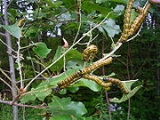
Anisota senatoria
Encyclopedia
The Orangestriped oakworm (Anisota senatoria) is a Nearctic
member of the family Saturniidae
and subfamily Ceratocampinae
. It is one of the more common Saturniids, reaching pest status occasionally in the northern parts of its range. As they are late-season feeders, however, they do little lasting damage to their hosts (most of the energy has been stored already).
It is very similar to A. finlaysoni in southern Ontario and A. peigleri in the southern USA.

in the early instars and often do not disperse much in the late instars. The fifth instar is black with yellow-orange stripes on its side, and prominent spiny horns on the second segment of the thorax, and about 5 cm long. Smaller spikes occur on the remaining segments. They feed on oaks in August and September.
, the adults do not feed. Their mouthparts have been reduced.
Females are stout bodied, yellow-orange with a silver-white spot and faint black line across the forewing. There is also a line across the hindwing. Males are much smaller, and red-brownish, but also have the white spot and pale lines. Both are speckled with black spots. Wingspan 3–5 cm.
s, Quercus species, especially red oaks (Tuskes et al. 1996). Wagner (2005) also reports chestnut, birch, hazel, hickory and maple.
Butterflies and Moths of North America: Anisota senatoria
Nearctic
The Nearctic is one of the eight terrestrial ecozones dividing the Earth's land surface.The Nearctic ecozone covers most of North America, including Greenland and the highlands of Mexico...
member of the family Saturniidae
Saturniidae
The Saturniidae, commonly known as saturniids, are among the largest and most spectacular of the moths. They form a family of Lepidoptera, with an estimated 1,300 to 1,500 described species worldwide...
and subfamily Ceratocampinae
Ceratocampinae
Ceratocampinae is a subfamily of the family Saturniidae.This subfamily contains the following genera:*Adelocephala Herrich-Schäffer, 1854*Adeloneivaia Travassos, 1940*Adelowalkeria Travassos, 1941*Almeidella Oiticica, 1946...
. It is one of the more common Saturniids, reaching pest status occasionally in the northern parts of its range. As they are late-season feeders, however, they do little lasting damage to their hosts (most of the energy has been stored already).
It is very similar to A. finlaysoni in southern Ontario and A. peigleri in the southern USA.
Range
Eastern North America, from the edge of the Great Plains to the east coast and from Southern Ontario to central Georgia, Alabama and East Texas. It is not found in Florida and is more common in the north.when eating oak leaves it decreases the size.Egg
Eggs are laid on the underside of leaves in large clusters. They take one to two weeks to hatch.
Larva
Larvae are gregariousSocial caterpillars
The collective behaviors of social caterpillars falls into five general categories: collective and cooperative foraging, group defense against predators and parasitoids, shelter building, thermoregulation and substrate silking to enhance steadfastness....
in the early instars and often do not disperse much in the late instars. The fifth instar is black with yellow-orange stripes on its side, and prominent spiny horns on the second segment of the thorax, and about 5 cm long. Smaller spikes occur on the remaining segments. They feed on oaks in August and September.
Pupa
As with most of this subfamily, when the caterpillars are ready to pupate, they burrow underground. Just before that, they may be seen wandering to locate pupation sites.Adult
Adults emerge once a year to mate, in mid-June to mid-July. Mating occurs in the middle of the day, and females lay eggs late in the day. As with all of SaturniidaeSaturniidae
The Saturniidae, commonly known as saturniids, are among the largest and most spectacular of the moths. They form a family of Lepidoptera, with an estimated 1,300 to 1,500 described species worldwide...
, the adults do not feed. Their mouthparts have been reduced.
Females are stout bodied, yellow-orange with a silver-white spot and faint black line across the forewing. There is also a line across the hindwing. Males are much smaller, and red-brownish, but also have the white spot and pale lines. Both are speckled with black spots. Wingspan 3–5 cm.
Food plants
OakOak
An oak is a tree or shrub in the genus Quercus , of which about 600 species exist. "Oak" may also appear in the names of species in related genera, notably Lithocarpus...
s, Quercus species, especially red oaks (Tuskes et al. 1996). Wagner (2005) also reports chestnut, birch, hazel, hickory and maple.
See also
Bug Guide to AnisotaButterflies and Moths of North America: Anisota senatoria

